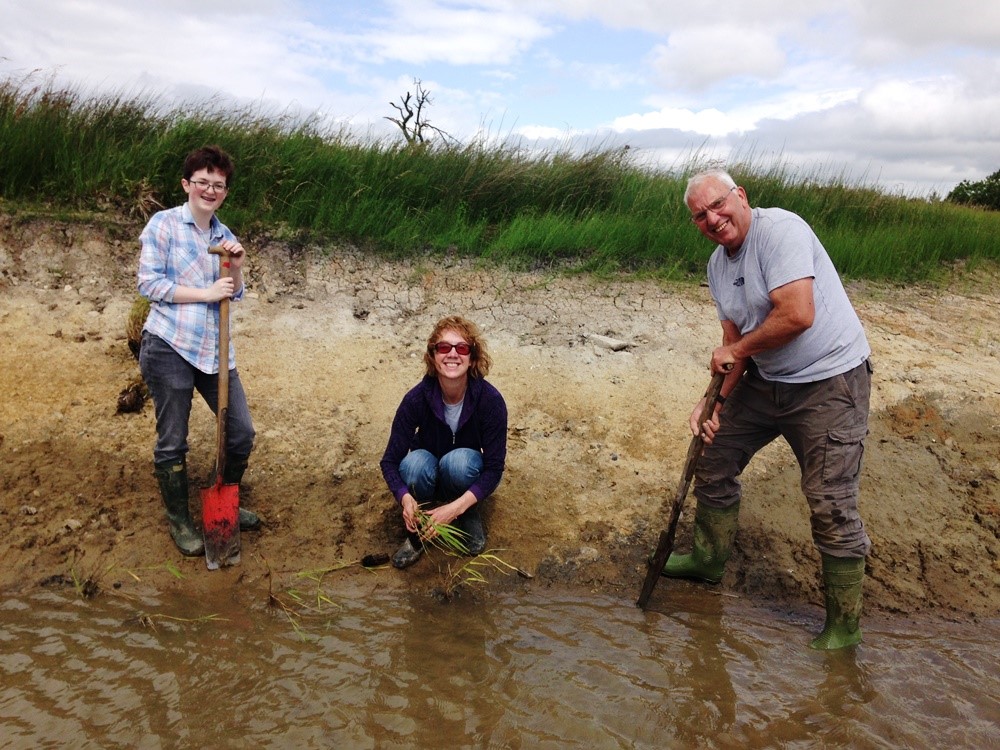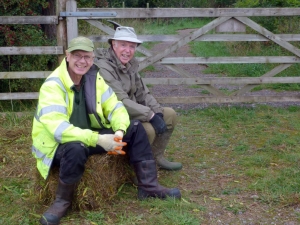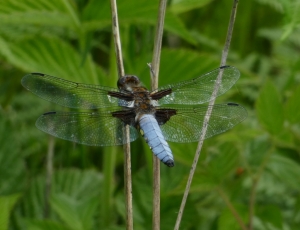Blog Archive (14) Posts Made in August 2020
Rain
Friday, August 28th 2020
A great deal of rain has fallen over the last few days and the quiet streams and becks on the reserve are now in spate. The volunteers carried out a great deal of work on the cascading ponds to ensure that the fast flowing water did not undermine the dams. They have been successful.

The lake looked rather forbidding in the overrcast conditions.

Risedale Beck was also fast flowing and could be heard as you approached it. Ripening Hawthorn berries can be seen overhanging the beckside, a sure sign of autumn.

The dampness is beginning to create the right conditions for some fungi to flourish. A beautiful Dryad's Saddle has again grown on the stump of an old Ash tree.

Unfortunately it was the wrong sort of rain for water droplets!
Late Summer Flowers
Thursday, August 27th 2020
The last of the summer flowers bloom through August and depending on the weather, stay out through to October. They provide a welcome supply of food for many insects, including bees and butterflies.
Some of these flowers can be found across the reserve but some only grow in a certain area. Grass of Parnassus is one of these. It does have a problem as to where it belongs. Some authorities say it is in a family all of its own, Parnassiaceae, others say it is related to the Saxifrage family whilst yet another places it in the Celastraceae family. Wherever it belongs it is a beautiful addition to the autumn flora.

Harebells are spreading across the moor.

Devil's Bit Scabious grows on the moor and in the Scrapes and is often covered with butterflies and bees.

Sawwort is not a flower that could be called beautiful but is another that provides food for butterflies and bees. It is also slowly spreading its range.

Some summer flowers are still in flower, athough looking a little worse for wear, like this Greater Spearwort.

Backgrounds
Tuesday, August 25th 2020
Views stay still. Flowers and trees can usually be photographed easily without a background to worry about, but insects, that is a totally different matter!
Hemp Agrimony is ideal for the late summer butterflies to feast upon and the background is good.

Catching a grasshopper on a green leaf is good to show camouflage.

A Common Darter on fading Gorse flowers could be good for camouflage but does not really show off the darter to its full advantage.

At this time of year the wasps are busy collecting scrapings of wood from our benches and bridge rails. Not the most inspiring of backgrounds.

Chinese Character Moths do not often arrive in the moth trap, preferring the walls of the Field Centre. Carefully removing the first one I saw and placing it on a leaf was a total failure, as it flew off. Next one I photographed on the nice shiny Field Centre wall, before transferring it to a leaf from whence it flew off!

The best background goes to the Southern Hawker female who landed on the boardwalk, when it had all the lovely green vegetation to rest upon.

Friends and Volunteers
Wednesday, August 19th 2020
As usual, volunteers have been working hard behind the scenes on all different kinds of tasks in order to keep the reserve running smoothly. Thanks to Katie Awdas, editor of Undergrowth (the reserve's newsletter), Friends and volunteers will soon receive an update on the LNR. Some of the regular mid-week volunteers took a break from working in the rain yesterday to carry out the necessary administration.
Others braved the wet conditions and continued installing new waymarker posts on the green route.
The moth recorders caught hundreds of moths last night and spent most of today identifying the many different species.
Thank you to everyone involved for your support.
For more information on becoming a Friend or Volunteer visit our 'support us' page.
Family Fun
Wednesday, August 19th 2020
Looking for something to do with the family? Due to popular demand an additional Pond Dipping event has been planned for Wednesday August 26th. See the events page for details (booking is essential).
You can also have a go at our Minibeast treasure hunt; take a walk around the Red Route (easy access trail) and look out for the minibeast clues. There are lots of fun facts to learn on the way! Pick up a clue sheet from the Field Centre for 50p and bring a pencil with you to tick off the creatures from the list as you go! This is a self guided activity so no need to book!
CES 11
Wednesday, August 19th 2020
The penultimate CES (Constant Effort Site) bird ringing session for 2020 took place last weekend. Over 150 birds were processed including two juvenile Whitethroats. These medium sized warblers spend the winter in Africa, leaving the UK in early October and heading as far as South Africa.
Another highlight for the team was this juvenile male Sparrowhawk.
Sparrowhawks are small birds of prey. They're adapted for hunting birds in confined spaces like dense woodland, so parts of the reserve are ideal hunting grounds for them.
Late Summer Jobs
Monday, August 17th 2020
During August, a start is made on managing some of the glades around the reserve. Glades are an important feature within a woodland setting as they offer a contrasting habitat to the higher canopy. Many insects find refuge and food in these small patches of ground that is not found elsewhere. These areas require sensitive management practises and if they were left undisturbed they would become taken over by bramble and bracken which would overcrowd the flowers and grasses. The glades at Foxglove are managed as 'mini hay meadows' to encourage the growth of wildflowers. Once the flowers have gone over, they are cut and then the cuttings are raked up and removed to keep the soil fertility down.

The 'mini meadows' are not the only places where strimming is necessary; with the good 'growing weather', footpath edges have had to be constantly cut back and this will continue for a few weeks yet!

Volunteers have also been busy weeding out invasive trees from the heathland paddocks. This is an ongoing task and a tough one as for it to be a success, the roots need to be dug out.

The Foxglove team have been having some additional help with heathland management from the Hebridean sheep (Thor and his gang) who are eating the rushes and grasses that compete with the heather.
Other 'browsers' include the many Roe deer that live on the reserve. Gerry captured these ones using a wildlife camera trap last week. These beautiful animals feed on tree shoots and leaves, herbs, brambles, ivy and other woody plants.
This one looks like one of this years young. Known as kids or fawns, they are born with a spotted coat to provide camouflage from predators. For the first few months of their lives, the kids are left hidden in long grass and only visited by their mother for short periods to suckle. They then begin to accompany their mother before eventually setting out to find a territory of their own.
If you walk quietly through the woodland then you will have a chance of encountering a roe deer at Foxglove. If you spot them from a distance they may stand and observe you for a short while before moving off. If you take one by surprise it will bound away with its white rump flashing and may even make a barking alarm sound a bit like a dog!
Ringathon!
Wednesday, August 12th 2020
The bird ringers have just completed a four day ringing course with some guest bird ringers from the South of England. The team went to various local sites as well as spending a day at Foxglove and as usual, there were some real surprises in store. The biggest of which was catching a Fieldfare as at this time of year they should all be in Scandinavia! Fieldfares are large, colourful thrushes, much like a mistle thrush in general size, shape and behaviour. They are very social birds, spending the winter in flocks of anything from a dozen or two to several hundred strong. These noisy flocks over farmland are usually a winter scene in the UK.
It was an adult male so has it just arrived early (they usually arrive from October onwards) or could it have overwintered in the UK? There was much discussion amongst the team members however, we may never find out!
Other highlights included some young Tree Pipits that were caught on the Catterick Training Area.
They are very similar to Meadow Pipits but, on close inspection, may be distinguished by their heavier bill, shorter hind claw and fine streaking on the flank - they also have very different calls. Widespread summer visitors to the UK, they occur in particularly high densities in Western uplands. Their population has undergone declines over the past 25 years, especially in central and southern England so it was good to find a few.
Another summer visitor, the Redstart, can be seen in the UK from April to October. It is included on the Amber List of species with unfavourable conservation status in Europe where it is declining. This juvenile was ringed during the weekend course.
In the photograph below you can see the striking red tail feathers.
However, in terms of look there was competition from a male Redpoll still in its breeding plumage! This tiny finch - only slightly bigger than a blue tit - is streaky and brown with patches of red on its head and sometimes its breast. They like to hang upside down to feed in trees.
This Whitethroat was a different bird for the group to see as they are not found at the reserve. Whitethroats are medium-sized warblers, about the size of a great tit. They have quite a long tail which they flick as they dart rapidly in and out of cover. They are summer visitors and passage migrants, with birds breeding widely, although they avoid urban and mountainous areas. They spend their winters in Africa, south of the Sahara.
It was a successful few days with well over 300 birds being ringed in total and a great learning opportunity for the bird ringers to enjoy. Thank you to everyone involved in whatever way from strimming and pruning net rides and filling bird feeders to providing essential chocolate and ringing the birds!
Wildlife Photography
Tuesday, August 11th 2020
The team at Foxglove are so busy that they rarely have time to stop and take photographs so it is always a treat when visitors share theirs. George Bond spent some time in the scrapes area on his visit and has very kindly shared these stunning pictures of young toads and frogs.
We are always grateful of photographs which can be used for the website, social media, displays in the Field Centre and calendars and leaflets and give credit to the photographers.
These are so beautiful that we had to share them!
If you have any pictures that you are happy for us to use please email them to us at foxglovecovertlnr@btinternet.com (for the blog they need to be at least 2mb).
Thank you again to George and keep up the good work!
Minibeast Safaris
Thursday, August 6th 2020
'Family bubble' minibeast safaris have been taking place this week. Much fun has been had searching around the outdoor classroom for invertebrates such as spiders, worms, woodlice, slugs and snails!
Other finds included frogs and newts.
If you would like to have a go then there are still limited sessions available to book on 12th August, for more details please see the events page.
Important Information
Thursday, August 6th 2020
Government guidelines mean that anyone using the Field Centre from Saturday 8th August must wear a mask. Please bring one with you if you intend to come inside.

Thank you for your understanding.
Ducks!
Tuesday, August 4th 2020
The clearing of the duck trap by volunteers paid off and already three young Mallards have been caught and ringed. They were fitted with a BTO ring then weighed and their wing measurements were taken before they were released back onto the lake.

This brings the total of Mallards ringed at the reserve to 15.
Reedbed Ringing
Monday, August 3rd 2020
Some of the bird ringers spent a few hours at a reed bed on a different site and caught 65 birds including 12 Reed Buntings and 10 Reed Warblers. This adult male Kingfisher was a highlight of the morning, it was a new bird (one that had not been ringed before).

The cobalt blue on its back was striking and one of the features used to identify it as a male.

Another colourful bird was a juvenile Green Woodpecker. These stunning birds are the largest of the three breeding woodpecker species found in the UK and unlike the others they rarely drum on trees and prefer to feed on ants.

Although ordinary in appearannce, this Spotted Flycatcher was another unusual bird for the ringers to encounter. As the name suggests, they enjoy feasting on flying insects, which they catch mid-flight. Butterflies, moths, damselflies and craneflies make up this bird’s diet. Wasps and bees also feature, which it makes safe to eat by rubbing the sting end on its perch, removing it.

It was a fascinating ringing session with some very special birds including a Cetti's Warbler that had been ringed eleswhere (a control) and a new juvenile one too. It will be interesting to find out where the Cetti's Warbler was first ringed.
Mulleins
Saturday, August 1st 2020
A new flower was added to the species list last week; Great Mullein. Just a single one was found along the access road not far from the Field Centre. The yellow, candle-like flower spikes of this impressive flower can reach up to 2m in height. It prefers dry and grassy ground, including gardens, waste ground and roadside verges. It is a biennial, spending its first year as a rosette of furry leaves, and producing its flowers in its second year, between June and August.
As if by coincidence, visitors photographed a Mullein Moth caterpillar in the same week. The larval foodplants of this moth include wild and cultivated mulleins, Common Figwort (pictured here), Water Figwort and buddleias.

The moth recorders had another good catch, a highlight was this Antler Moth with its diagnostic cream antler like mark. This moth is on the wing from mid July to mid September, it is attracted to light during the night but also flies during the day.
Early Thorn is another distinctive species; the resting position of this moth distinguishes it from all other British thorns, with wings held back and close together, similar to a butterfly. The caterpillars feed on a variety of deciduous trees, including Blackthorn (Prunus spinosa), Hawthorn (Crataegus), Hazel (Corylus), Silver Birch (Betula pendula), Alder (Alnus) and Sallows (Salix) all of which are abundant at Foxglove!

































